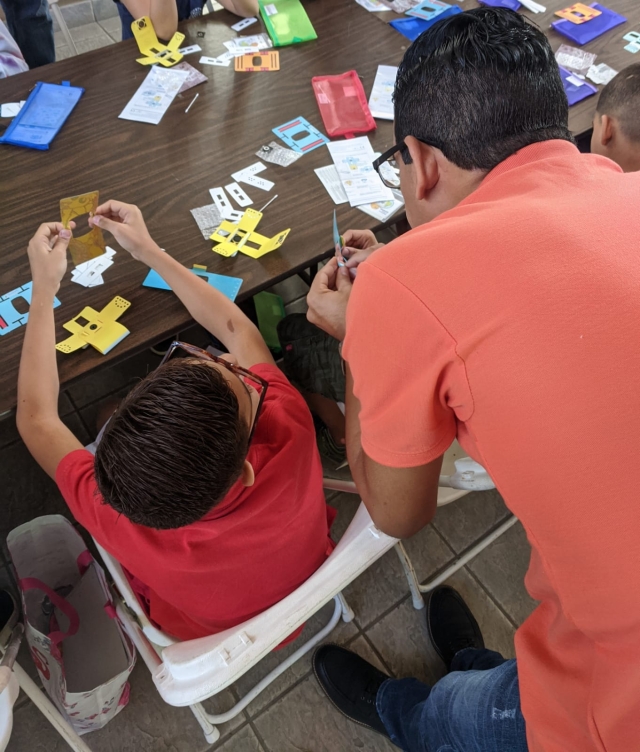CienciaPR Supports Educational Continuity in Southwestern Puerto Rico
Submitted by Greetchen Díaz-Muñoz on
It felt like a birthday party. Children running around and playing on the swings. As soon as they arrived, parents asked for the teacher and made their way towards the home-made banners that corresponded with their kids’ grade to sign them up. When the call for the start of classes rang, the little ones started settling down. We had to add a table because there wasn’t space for everyone. Then there weren’t enough chairs, and some kids shared.
This was the scene we found at the “Educamos Donde Sea” (which loosely translates to “We Educate Anywhere”) camp at Las Delicias Park in Ponce. “Educamos Donde Sea” is a community- and volunteer-based initiative that provides continuity to school education in regions where the seismic sequence that has been affecting Puerto Rico since December 2019 has caused school closures and class cancellations. Nearly 50% of schools in the archipelago remain closed after a 6.4 magnitude earthquake on January 7, 2020—the strongest in more than a century. The semester was scheduled to begin on January 9. Some schools will not re-open until late February.
On January 24 and 25, my colleagues Elvin Estrada, Educational Programs Specialist for CienciaPR, Dr. Samuel Díaz Muñoz, Assistant Professor at the University of California, Davis and long-time CienciaPR volunteer, and I visited the “Educamos Donde Sea” camp and the Jack and Damaris Foster “Saturday School” in Cabo Rojo. Twenty-six sixth grade children and a parent welcomed us in Ponce, while 20 students ages 3rd through 6th grade, 4 parents and 3 educators participated in Cabo Rojo.
Grateful. After #earthquakes, many #schools in south #PuertoRico R closed. Educators created outdoor schools & had privilege with @CienciaPR @sociovirology @elvinjestrada 2 offer @TeamFoldscope workshop 4 6th grade in Ponce. #ifthenshecan #STEMed #WomenInSTEM pic.twitter.com/WRUKSvqMQZ
— Greetchen Díaz Muñoz, PhD (@greetchendiaz) January 26, 2020
The three of us are scientists, but we never told them it was a science class. We let them do and explore. Children and adults learned to assemble the low-cost Foldscope microscope and used it to investigate and discover the microscopic wonders around them. We provided earthquake activity books donated by the Vector Control Unit and the Puerto Rico Science Trust, school supplies and backpacks provided by the Hispanic Federation, and leaflets about mangroves courtesy of the Sea Grant program. We also distributed copies of the book ¡Ciencia Boricua! (published by us in 2011) and science lesson plans developed by CienciaPR with funds from the National Science Foundation (NSF) after Hurricane Maria.
“Elvin (who led the Foldscope workshop) asked me to prepare some sample slides. I made one with a Bougainvillea flower that caught my attention. When I looked through the little hole against the light, I saw the microscopic complexity that gave the flower its intense magenta color. One by one, the children described the petals. ‘They look like branches,’ one of the kids said. ‘They look like pink and white balloons,’ commented another," Samuel recalled.
Suddenly, it was very sunny and the tables had to be moved. The children were quite attentive and following instructions. As always some kids were ahead and helped their peers. One of them said: "I'm going to do it without the mister’s help" and of course, they called me missy (in Puerto Rico it is very common for children to call male teachers ‘mister’ and female teachers ‘missy’). There were a few of us “teachers" and we had our hands full, but we achieved our goal. We finished and thanked them for letting us teach them something new.
Thanks to my @CienciaPR colleagues @greetchendiaz @elvinjestrada for the opportunity to help bring @TeamFoldscope to students affected by the earthquakes in #PuertoRico #TemblorPR pic.twitter.com/lDwGUyQfRz
— Sam Díaz-Muñoz (@sociovirology) January 31, 2020
The conditions we found in Ponce and Cabo Rojo were adverse and overwhelming. Camps and alternate classrooms in southwestern Puerto Rico have emerged from the need and uncertainty surrounding the education of school-aged children. The communities that make up these camps and alternate classrooms also face great need and uncertainty—from the lack of resources and educational content, to not knowing when or if they will be able to return to their schools. As Samuel told me, “part of our goal was for science to be at once a distraction from the difficult conditions in their communities and a practical tool to advance the education of students. However, I hope that in the long term, science will be a tool to understand earthquakes and so many other phenomena that will create challenges and opportunities throughout their lives.”
This is not the first time that Puerto Rico has faced an educational crisis after a natural phenomenon. These situations have revealed an urgent need to develop the resilience of education systems, so that emergencies do not disrupt the teaching and learning process. After Hurricanes Irma and María, Ciencia Puerto Rico developed science lessons to make it easier for students to learn through projects relevant to natural disasters, and we assessed the feasibility of using these lessons in disaster-affected settings. We have learned a lot since then, but this new experience has shown us that these tools can equip educators and students with the ability to continue learning, even without a classroom.









